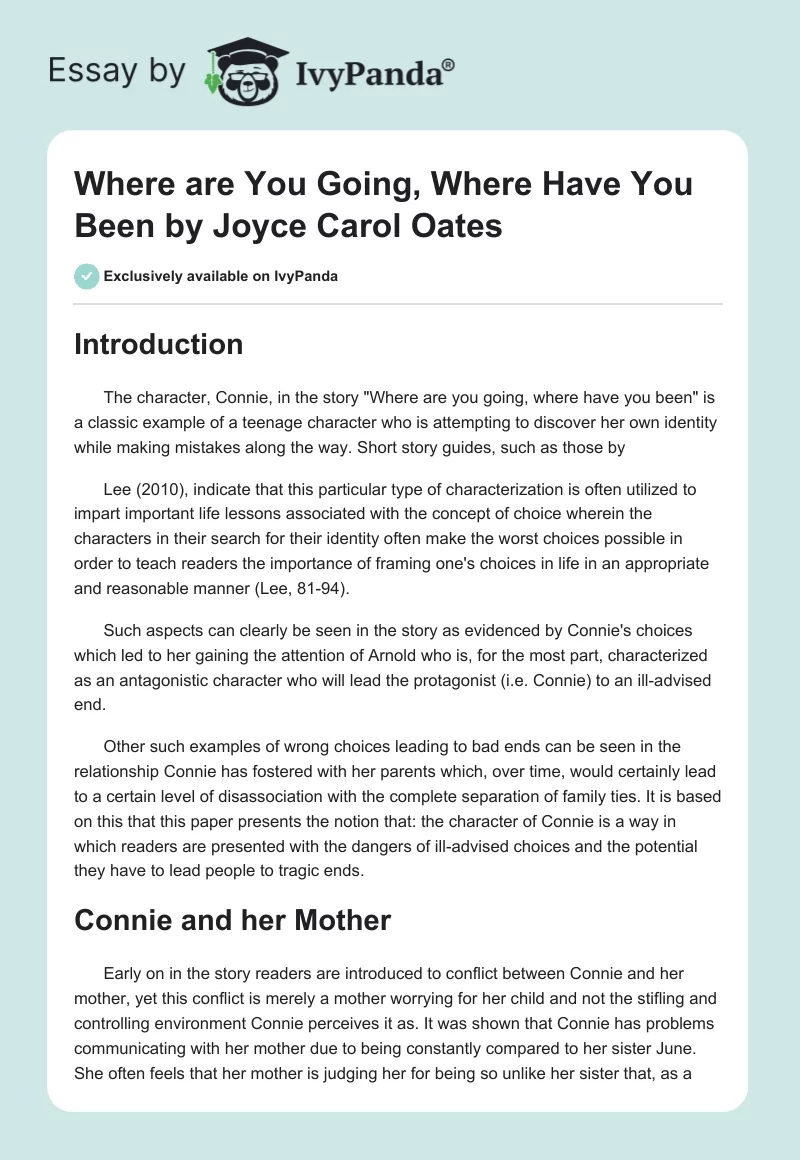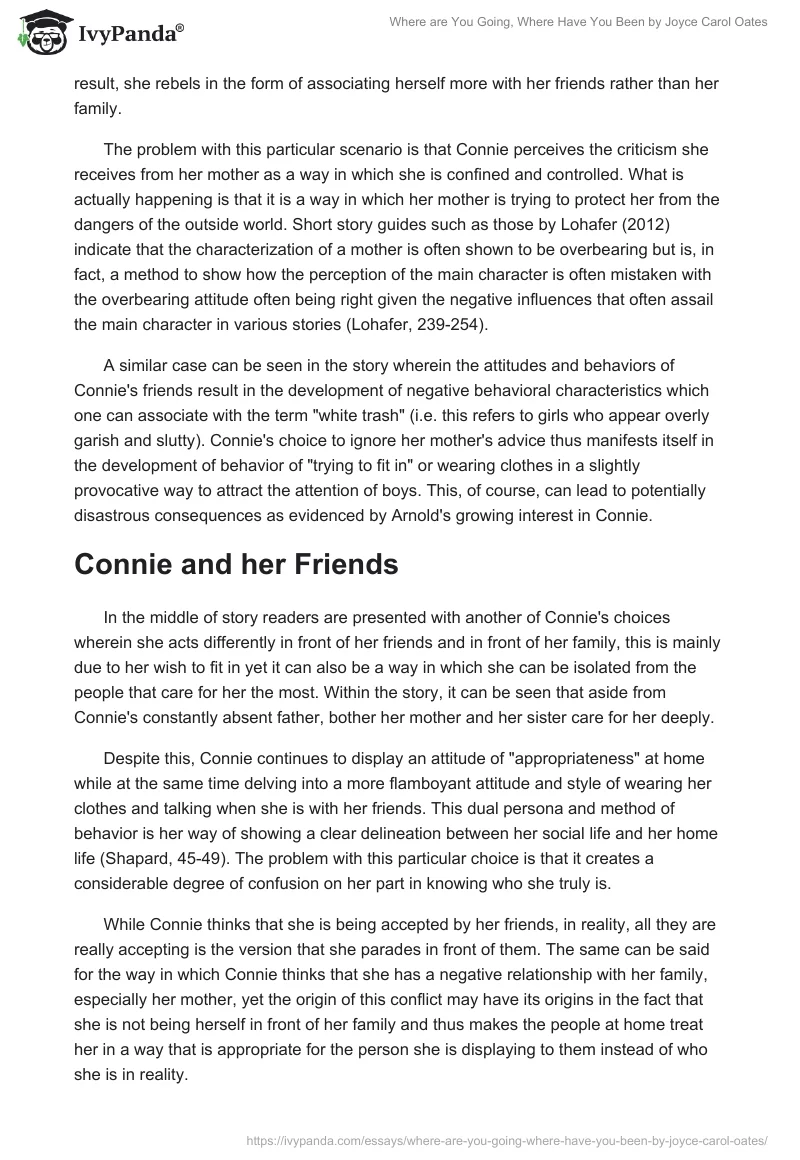Introduction
The character, Connie, in the story “Where are you going, where have you been” is a classic example of a teenage character who is attempting to discover her own identity while making mistakes along the way. Short story guides, such as those by
Lee (2010), indicate that this particular type of characterization is often utilized to impart important life lessons associated with the concept of choice wherein the characters in their search for their identity often make the worst choices possible in order to teach readers the importance of framing one’s choices in life in an appropriate and reasonable manner (Lee, 81-94).
Such aspects can clearly be seen in the story as evidenced by Connie’s choices which led to her gaining the attention of Arnold who is, for the most part, characterized as an antagonistic character who will lead the protagonist (i.e. Connie) to an ill-advised end.
Other such examples of wrong choices leading to bad ends can be seen in the relationship Connie has fostered with her parents which, over time, would certainly lead to a certain level of disassociation with the complete separation of family ties. It is based on this that this paper presents the notion that: the character of Connie is a way in which readers are presented with the dangers of ill-advised choices and the potential they have to lead people to tragic ends.
Connie and her Mother
Early on in the story readers are introduced to conflict between Connie and her mother, yet this conflict is merely a mother worrying for her child and not the stifling and controlling environment Connie perceives it as. It was shown that Connie has problems communicating with her mother due to being constantly compared to her sister June. She often feels that her mother is judging her for being so unlike her sister that, as a result, she rebels in the form of associating herself more with her friends rather than her family.
The problem with this particular scenario is that Connie perceives the criticism she receives from her mother as a way in which she is confined and controlled. What is actually happening is that it is a way in which her mother is trying to protect her from the dangers of the outside world. Short story guides such as those by Lohafer (2012) indicate that the characterization of a mother is often shown to be overbearing but is, in fact, a method to show how the perception of the main character is often mistaken with the overbearing attitude often being right given the negative influences that often assail the main character in various stories (Lohafer, 239-254).
A similar case can be seen in the story wherein the attitudes and behaviors of Connie’s friends result in the development of negative behavioral characteristics which one can associate with the term “white trash” (i.e. this refers to girls who appear overly garish and slutty). Connie’s choice to ignore her mother’s advice thus manifests itself in the development of behavior of “trying to fit in” or wearing clothes in a slightly provocative way to attract the attention of boys. This, of course, can lead to potentially disastrous consequences as evidenced by Arnold’s growing interest in Connie.
Connie and her Friends
In the middle of story readers are presented with another of Connie’s choices wherein she acts differently in front of her friends and in front of her family, this is mainly due to her wish to fit in yet it can also be a way in which she can be isolated from the people that care for her the most. Within the story, it can be seen that aside from Connie’s constantly absent father, bother her mother and her sister care for her deeply.
Despite this, Connie continues to display an attitude of “appropriateness” at home while at the same time delving into a more flamboyant attitude and style of wearing her clothes and talking when she is with her friends. This dual persona and method of behavior is her way of showing a clear delineation between her social life and her home life (Shapard, 45-49). The problem with this particular choice is that it creates a considerable degree of confusion on her part in knowing who she truly is.
While Connie thinks that she is being accepted by her friends, in reality, all they are really accepting is the version that she parades in front of them. The same can be said for the way in which Connie thinks that she has a negative relationship with her family, especially her mother, yet the origin of this conflict may have its origins in the fact that she is not being herself in front of her family and thus makes the people at home treat her in a way that is appropriate for the person she is displaying to them instead of who she is in reality.
Fiction guides such as those by Packard (2012) elaborate on this concept by indicating that the dual nature of attitudes displayed by various fictional characters either in front of their friends or at home is a way in which author usually shows the impact of the poor choice of trying to fit in with others on a social level (Packard, 18-21).
Such an aspect can clearly be seen in the story wherein readers are privy to the fact that Connie’s friends merely like her for the way she acts with their general concern for her being mainly superficial. This is in stark contrast to the way in which her family worries about her which are based on love and affection. It is from this perspective that the characterization of Connie as a means of showing the impact of ill-advised choice further solidifies itself.
Connie and her Home Life
On a relatively minor note, within the story it can be seen that Connie promptly ignores the various chores she has to do at home in favor of continuing to act out and be with her friends, this represents another ill-advised choice on the part of Connie since this instills a certain degree of irresponsibility. What you have to understand is that the concept of irresponsibility is often utilized as a plot device in order to show ill-advised actions which often result in the character winding up in a perilous situation. This was shown in the case of Connie wherein she ignored her household chores and leads up the negative result of Arnold developing an interest in her (PIGLIA, 63-66).
Conclusion
Based on the various facts and arguments that have been presented within this paper it can be seen that the character of Connie is a way in which readers are presented with the dangers of ill-advised choices and the potential they have to lead people to tragic ends. This evidenced by the fact that as a direct result of all her choices Connie wound up gaining the attention of Arnold.
Works Cited
Lee, Richard. “Narrative Point Of View, Irony And Cultural Criticism In Selected Short Fiction By George Saunders.” Short Story 18.1 (2010): 81-94. Literary Reference Center.
Lohafer, Susan. “Dialogues.” Narrative 20.2 (2012): 239-253. Literary Reference Center.
Packard, Gabriel. “Making You FEEL And Making You THINK.” Writer 125.7 (2012): 18-21. Literary Reference Center.
Piglia, Ricardo. “Theses On The Short Story.” New Left Review 70 (2011): 63-66. Academic Search Premier.
Shapard, Robert. “The Remarkable Reinvention Of Very Short Fiction.” World Literature Today 86.5 (2012): 45-49. Literary Reference Center.


